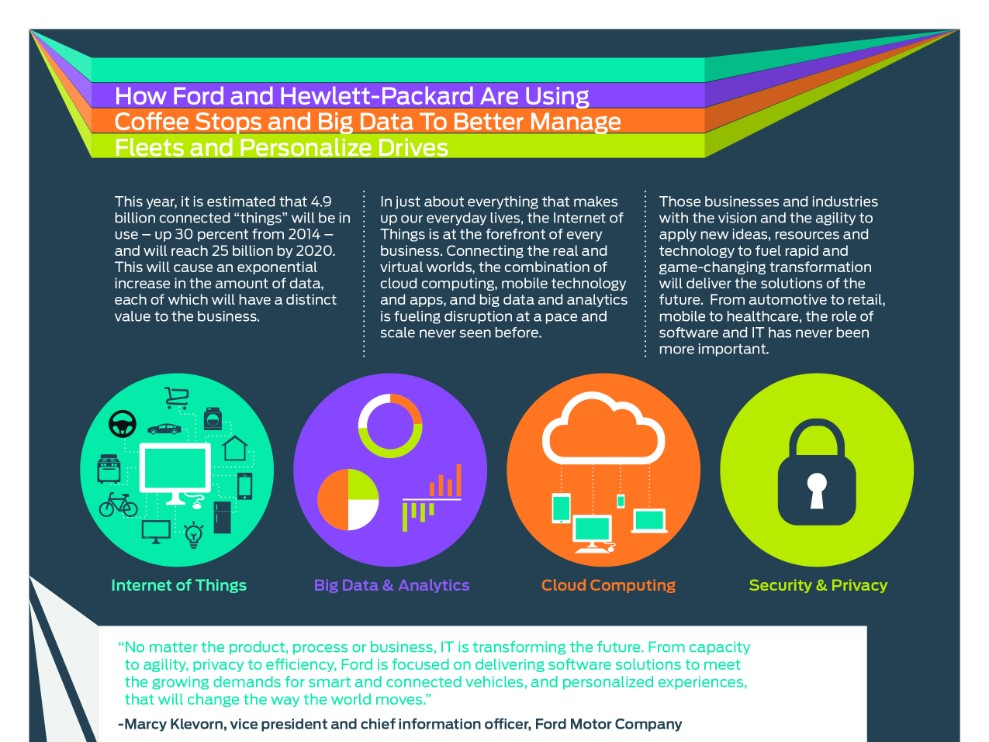
- Ford and HP Fleet Insights experiment analyzes information from daily driving to lead to more efficiently managed fleets, car sharing and personalized driving experiences
- Experiment gathered information from national HP fleet vehicles and HP employee volunteer drivers around the U.S., learning HP drivers share similar coffee, airport parking and refueling habits, which could be leveraged to reduce operating costs while improving convenience and services
- The Fleet Insights experiment is one part of the Ford Smart Mobility plan aimed at better understanding consumers’ mobility needs around the globe
Using HP’s Big Data Discovery Experience Services and the HP Haven big data platform, the engineering team gathered data and analyzed it to determine possibilities for lowering operating costs and optimizing underutilized vehicles for fleets as well as personal driving.
Among the observations of the experiment: Regardless of location, most HP drivers grabbed coffee at the same national coffeehouse and refueled with the same brand of gasoline, while traveling employees often left vehicles unused at the airport for days.
While it’s no surprise road-tripping employees stop for coffee, data analysis about commutes and driving routines could lead to greater economies of scale for company fleets and new solutions for optimizing underutilized vehicles.
“The Fleet Insights experiment is one of the first steps to better understand and learn about how driving behavior is changing,” said Marcy Klevorn, Ford vice president and chief information officer. “Fleets could see operating costs lowered through national buying contracts and improved utilization and maintenance, while individual drivers could receive coupons or create cooperative pools to share unused vehicles.”
The Ford Fleet Insights experiment included HP fleet vehicles that were equipped with wireless sensors plugged into each vehicle. Ford data scientists and IT leaders used the HP Vertica analytics engine, part of the HP Haven platform, to explore patterns and multiple dimensions of fleet driver activity. Also, each driver could access their data using a custom smartphone app to recall trip details, if needed.
“HP and Ford share a common vision around bringing together data, mobility, and analytics to explore new ways to deliver better customer experiences, new revenue streams, and lower fuel and maintenance costs in the automotive industry,” said Martin Risau, senior vice president, Analytics & Data Management Practice, HP Enterprise Services. “The results of this experiment can help unleash improvements for business operations for fleet management and personal driving experiences.”
Observations during the experiment included:
- Regardless of location, most drivers visited the same national coffee house and refueled with the same brand of gasoline
- Traveling employees often left their vehicles unused at the airport for days. These vehicles could be utilized more effectively by nearby drivers
- 70 percent of trips took place during weekdays and typical trip distances were 13 miles or less
- City block driving (34 percent): Involved frequent direction changes, driving near the speed limit, idling at stoplights with short distances.
- Freeway driving (21 percent): Involved few driving direction changes with large deviations from the speed-limit depending on traffic, and long trip durations and driving distances with less stop and go than City Block Commute.
- Non rush-hour Driving (29 percent): Short trip duration and short-distance with less stops and idling
- Rush-hour driving (16 percent): Short trip duration and short-distance with frequent stops and idling during peak drive hours

No comments:
Post a Comment